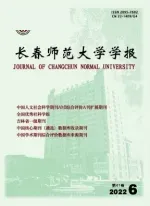匹配關系在兒童故事中的應用
宮金玲,于 娜
(遼寧師范大學外國語學院,遼寧大連 116029)
一、語義單位關系及匹配關系
語義單位關系 (clause relation)的概念最早是由Quirk提出的,他主要分析了讓步關系 (concessive relation)在古英語當中的應用。在此基礎上,Winter和 Hoey發展了語義關系這一理論,他們認為語篇的各個部分所形成的連貫可以從句子之間或句群之間存在的語義單位關系角度來解釋。語義單位關系理論可分為兩方面:一方面,把一個句子放在它周圍句子的語境中,從而表明只有考慮這個句子的大的語境,它的語法和語義才能得以完全解釋;另一方面,把語篇看作一個整體,而不考慮其中任何一個單獨的句子[1]。
首先,Winter從讀者和聽者的角度,對語義單位關系作出了解釋。在Winter研究的基礎之上,Hoey從語篇作者的角度對語義單位關系的定義作了補充,并且把語義關系這一研究方法運用到對篇章的分析中。綜合Winter和Hoey的觀點,語義單位關系可以被定義為:在一個相同語篇中,根據相鄰句子或句群來理解一個句子或句群意思的認知過程;也是我們根據相鄰句子或句群選擇語法、詞匯和語調來生成句子或句群的認知過程[2]。
語義關系有兩個基本的類型,即匹配關系(matching relation)和順序關系(sequence relations)。這些關系在語篇中可以通過各種標識手段來識別。常見的標識手段主要包括標識詞(Signals,如subordinator,conjuncts,lexical signals,repetition等),并可以通過解釋(paraphrase)和提問(question)來明確這種關系。
邏輯關系指的是連續事件或思想之間的關系(不論是真實的還是可能的),最為典型的就是時間順序。匹配關系是指語句在描述的相同程度上相匹配的關系,包括對立匹配(contrast)和一致性匹配(compatibility)。其中,重復(repetition)是匹配關系的主要手段之一。重復包括簡單重復(simple repetition)、復雜重復(complex repetition)、替代(substitution)、省略(ellipsis)和解釋(paraphrase)。所謂簡單重復指相同的詞語在語篇中出現;在復雜重復中,重復的詞語詞性不同;替代指的是用人稱代詞、指示代詞、指示副詞等去替代上下文所出現的詞語。而省略可看作一種特殊的替代——零替代(substitution by zero);而解釋又可以分為簡單解釋和復雜解釋。Hoey認為重復的作用在于:當兩個句子有相同的部分的時候,讀者會更關注變化的部分,而重復的部分對讀者理解新的變化的部分充當一種支架作用。[1]
二、兒童故事中匹配關系的實例分析
匹配關系經常出現在兒童故事中,而其他故事類型卻沒有如此鮮明的特點。
為了說明兒童故事中匹配關系的高出現率,本應以大量數據來進行分析說明。但是限于篇幅,本文僅以“G oldilocks and the three bears”中的幾個段落為例,作一些具體分析。為便于分析,文章的句子以S作為標記,并都標上了序號。
例1:
S.2.Father bear was a very big bear.
S.3.Mother bear was a medium-sized bear.
S.4.Baby bear was a tiny,little bear.[3]
這三個句子通過簡單重復這一標識手段形成了匹配關系。通過兩組反義詞——關系反義詞“father-mother-baby”和對立反義詞“big-medium-sized-little”,形成了對比匹配關系。
例2:
S.17 Goldilocks saw the three bowls of porridge and the three spoons on the table.
S.18-19 Goldilocks picked up the very big spoon and tasted the porridge in the very big bowl.It was too hot.
S.20-21 Then she picked up the medium-sized spoon and tasted the porridge in the medium-sized bowl.It was lumpy.
S.22-23 Then she picked up the tiny,little spoon and tasted the porridge in the tiny,little bowl.It was just right.
S.24 Soon she had eaten it all up.
S.25 Then Goldilocks saw three chairs:a very big chair,a medium-sized chair and a little chair.
S.26-27 She sat in the very big chair.It was too high!
S.28-29 Then She sat in the medium-sized chair.It was too hard!
S.30-31 Then She sat in the tiny,little chair.It was just right!
S.32-33 But Goldilocks was rather heavy for the tiny,little chair.The seat began to crack and then it broke.
S.34 Next Goldilocks went into the bedroom,and then she saw three beds:a very big bed,a medium-sized bed and a little bed.
S.35-36 She climbed up onto the very big bed.It was too hard!
S.37-38 Then She climbed up onto the medium-sized bed.It was too soft!
S.39-40 Then She climbed up onto the tiny,little bed.It was just right!
S.41 Soon she was fast asleep.
在“G oldilocks偷喝小熊的粥”這一段,文章運用了兩種重復手段——替代“G oldilocks/she”和簡單重復,形成了這一部分的框架結構“G oldilocks/she picked up the…spoon and tasted the porridge in the…bowl.It was….”每兩句形成的一組20個單詞當中,只有五個單詞是變量,也就是說,在這組句子當中,有75%的成分是重復的。S.18-19和S.20-21都是說粥不好喝,用“hot-lumpy”形成了一致性匹配關系。而S.18-21這四句話又和S.22-23通過反義詞“hot/lumpy-right”形成了對比匹配關系。
在“椅子”和“床”兩部分,文章繼續沿用“喝粥”這一部分的句子之間關系,或一致性匹配,或對比匹配。而這三部分之間通過重復的手段又形成了一致性匹配關系。
圖1可以清晰地顯示匹配關系在這篇兒童故事以上三部分中的運用:

圖1
三、結語
Nodelman在他的The Pleasures of Children's Literature一書中指出,教育的一個基本假設就是:重復一個任務會有助于學習[4]。而重復是匹配關系的重要的標識手段。因此,鑒于兒童故事的教育認知目的,兒童故事顯示出高頻率的匹配關系,對于實現語篇連貫,幫助兒童的語言認知具有重要意義。
[1]Hoey.M..On The Surface of Discourse[M].London:George Allen and Unwin,1983:17,25.
[2]Hoey.M.,Eugene Winter.“Clause Relations and the Writer's Communicative Task”[M]//COUTUREB.Functional Approaches to Writing Research Perspectives.London:Frances Printer,1986:123.
[3]McClintock Barbara.G oldilocks and the three bears[M].Columbia:Scholastic Press,2003.
[4]Nodelman Perry.he Pleasures of Children's Literature[M].New York:Longman,1996:161.

